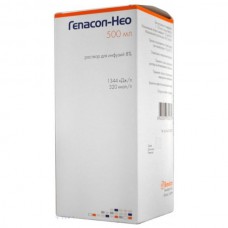Expiration date: 08/2025
The composition and form of issue:
Solution for infusion 8% 1000 ml contains:
L-valine of 10.08 g
L-isoleucine 10.4 g
L-leucine of 13.09 g
L-lysine 6,88 g
(corresponds to L-lysine to monoacetate) of 9.71 g
L-methionine 1.1 g
L-threonine 4.4 g
L-phenylalanine 0.88 g
L-tryptophan 0.7 g
L-alanine of 4.64 g
L-arginine of 10.72 g
a solution of 5.82 g
L-histidine, 2.8 g
L-Proline of 5.73 g
L-serine of 2.24 g
L-cysteine 0,52 g
(corresponds to N-acetyl L-cysteine) 0.7 g
auxiliary substances: glacial acetic acid — 4,42 g water for injection to 1000 ml
energy value — 1344 kJ/l (320 kcal/l) theoretical osmolality — 770 mOsm/l pH to 5.7 and 6.3
in bottles of 500 ml in a cardboard pack of 1 or 10 vials (for hospitals).
Description pharmaceutical form:
Transparent solution from colorless to slightly yellow.
Feature:
Combined preparation, which is a solution of amino acids.
Pharmacokinetics:
Hepasol-Neo contains a variety of amino acids, which constantly enter the body with food.
Amino acids introduced into the body via infusion, are one of two possible metabolic pathways: anabolic pathway in which the amino acids bond by peptide bonds to form specific proteins, and catabolic path, in which the transamination of amino acids. Introduced as part of a complete parenteral nutrition with glucose and fats (the ratio of carbs and fats 70:30) with a speed of 10.5 mg nitrogen/kg/h achieve a balanced amino acid concentration in blood after 3 hours
Amino acids can be excreted unchanged with the rapid increase of their concentration in the blood. T1/2 amino acids (in healthy people) 5-15 min (this short period of time amino acids to be used for protein synthesis). Residues of amino acids used in the synthesis of proteins, subject to deamination, which produces urea removed from the body.
Arginine is almost completely reabsorbed in the renal tubules.
Metabolism of amino acids occurs in all tissues of the body. The degree of splitting depends on the severity of the stress, which is subjected to the body. Stress accelerates the metabolism of amino acids and strengthens the liver, which for its part reduces the metabolism of amino acids. Sepsis also speeds up their metabolism, and decrease kidney function — inhibits.
During infusion of Hepasol-Neo, the percentage of absorption of essential amino acids is 99%, and interchangeable up to 97%. The total and renal clearance of essential amino acids is 0.5 l/min, i.e., 1.5 ml/min, and for most non-essential amino acids — 0.6 l/min, i.e. 3 ml/min.
Description pharmacological action:
Hepasol-Neo is a combined product, which is a solution of amino acids.
In the product contains all 8 essential amino acids that the human body cannot synthesize (L-valine, L-isoleucine, L-leucine, L-lysine, L-methionine, L-threonine, L-phenylalanine, L-tryptophan), 2 conditionally essential amino acids — L-arginine, L-histidine are synthesized in insufficient quantities under certain pathophysiological conditions, and 5 non-essential amino acids, ensure adequate metabolism in patients with liver disease. Amino acids are in L form that provides for their direct participation in the biosynthesis of proteins (nitrogen content — a total of 12.9 g/l).
L-arginine promotes the conversion of ammonia into urea, binds toxic ammonium ions, formed during the catabolism of proteins in the liver.
L-alanine and L-Proline reduces the body's need for glycine.
L-isoleucine, L-leucine, L-valine (essential amino acids with branched side chains) directly absorbed by peripheral tissues (their metabolism is not dependent on the degree of liver damage), reduce the absorption and intake of aromatic amino acids in the Central nervous system, reducing symptoms of hepatic encephalopathy, and normalize the energy and nitrogen balance in the body.
Hepasol-Neo allows the correct amino acid disorders in liver failure, and significantly improve the tolerance of proteins in patients with cirrhosis of the liver, hepatitis and to reduce the symptoms of hepatic encephalopathy.
Does not contain carbohydrates and electrolytes.
Indications:
therapy and parenteral nutrition (partial or total — when you add solutions of carbohydrates and fat emulsions) in violation of liver function (liver failure) with impaired function of the brain (hepatic encephalopathy) or without
therapy of hepatic coma and before coma states.
Contraindications:
- hypersensitivity to the drug
- the metabolism of amino acids
- gipergidratace
- hyponatremia
- hypokalemia
- renal failure (hepatic coma in patients with renal insufficiency it is necessary to consider which of the two States threatens the patient's life)
- heart failure (decompensation)
- pregnancy
- lactation
- children up to age 18 years (effectiveness and safety have not been established).
Application of pregnancy and breast-feeding:
Application during pregnancy and lactation — efficacy and safety have not been established.
Side effects:
Side effects of the drug are not known.
Drug interactions:
There is evidence of interaction in vivo components of Hepasol-Neo with theophylline, leading to increased clearance of the latter.
Numerous data on the interaction in vitro, so do not add other drugs to the solution of the drug.
Drugs that can be entered together with Epsolon-Neo: antibiotics — amikacin, ampicillin, Cefotaxime, Ceftriaxone, doxycycline, erythromycin, gentamicin, chloramphenicol, clindamycin, netilmicin, penicillin, piperacillin, tetracycline, vancomycin and other drugs — theophylline, cyclophosphamide, cimetidine, cytarabine, digoxin, dopamine, famotidine, fitomenadion, fluorouracil, folic acid, furosemide, heparin, chlorpromazine, insulin, calcium gluconate, lidocaine, methyldopa, methylprednisolone, metoclopramide, methotrexate, morphine, nizatidin, norepinephrine, propranolol, ranitidine, Riboflavin.
Method of application and dose:
In/in, drip.
The treatment regimen depends on concentration of ammonia in the blood and severity of the disease.
It is recommended that the infusion with a speed of 1.0–1.25 ml/kg/h (30-35 drops/min), which corresponds to 0.08–0.1 g amino acids/kg/h.
The maximum infusion rate is 1.25 ml/kg/h (0.1 g amino acids/kg/h), the maximum daily dose is 18.75 ml/kg/day (1.5 g amino acids/kg/day), i.e., 1300 ml for a patient weighing 70 kg.
The duration of therapy is determined individually until the complete disappearance of neurological symptoms.
Overdose:
Symptoms: nausea, vomiting, sweating, fever, tachycardia, increase in liver enzymes and kontsentratsii residual nitrogen. Increased speed leads to over-hydration and the appearance of peripheral edema, development of pulmonary edema.
Treatment: symptomatic. Discontinue infusion of the drug, there is no specific antidote.
Special instructions:
Application solution Hepasol-Neo is only given to the testimony.
During application of this drug requires periodic monitoring of electrolyte balance and acid-base balance, the degree of hydration, condition of kidney function.
Should apply only the clear solution from the intact bottle!


